-
Posts
448 -
Joined
-
Last visited
-
Days Won
1
Content Type
Profiles
Forums
Blogs
Gallery
Events
Store
Posts posted by Richard LaTondre
-
-
The Pillars of State is actually harder to find, even though it is the junior of the two. Peterson claims there were 701 of the 3rd class Auspicious Clouds awarded up to 1940, but only 260 of the Pillars of State. Hence I would expect it to be more expensive notwithstanding its lower status.
That is very interesting information and it makes good sense as that trend also seems to prevail in the lower classes of the orders.
Thanks,
Dick
0 -
It will be interesting to see what this eventually goes for. High end Manchurian prices have started to rise recently since there is increased interest from China and Taiwan in these.
Hi Paul:
Three months ago I bought a 3d Class Auspicious Clouds on eBay for about US $1,200 in excellent condition. I would think that the Auspicious Clouds and the Pillars of State would be worth the same. This item is approaching double what I paid.
Dick
0 -
This is something you don't see too often, A Third Class Pillars of State up for auction. The bidding at this time is well over US 2K.
Dick
This item was received through the very kind thoughtfullnes of Dieter3.
http://page9.auctions.yahoo.co.jp/jp/auction/k114730032
0 -
It's a beautiful order, isn't it? Do you need some help in resizing the pictures?
Hugh
Thank you Hugh for your kind offer. Yes! I agree it is a beautiful medal. and Yes, I need help.
Regards,
Dick
0 -
Hello Gentlemen,
I will be soon for a short trip in Beijing and I would like to know if there is an area or some anitique shop with Medals & Orders,not necessary from China in Beijing ?
Please no junk shop area,I know how and how many fakes are now on market.
Thanks.
Emmanuel
Emanuel:
I wish you luck . . . . .
Richard
0 -
I received this item yesterday from Argentina. It is the Royal Order of Cambodia instituted in 1894, This one was issued by the Emperor of Cambodia. Weight with ribbon 34.7 grs
Size (w/o ribbon) 75 x 52 mm. Sorry, No pictures as I am informed the file is 'too big'
0 -
#2
They both seem to have similar symbols in common. The globe, the turtles, and the bluebirds. They may be representing the same unit/organization at different periods of time.
Dick
0 -
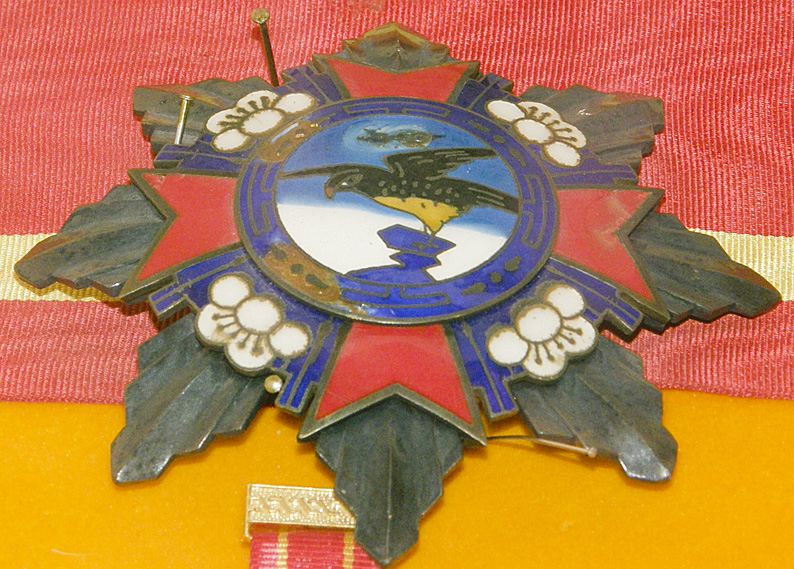
Hi Alex! Thanks for sharing that. I assume this photo was taken in the Presidential Building, Arts Museum, in TaiBei.
The Republic of China (ROC) Instituted this award on 8 November 1937. It was awarded for Distinguished Contributions to the National Defense under foreign invasion (not too many people are alive to meet those requirements) this is the Grade l (Grand Cordon Set.
The following is from the Awards and Seals Division, Taiwan:
"In 1929 the Nationalist government enacted a statute regulating decorations for the army, the navy and the air force, specifying the use of the Order of Blue Sky with a White Sun and the Order of Precious Tripod when honoring military personnel. Another law was passed in 1933 stipulating that the Order of Brilliant Jade with Grand Cordon and the China Order of Brilliant Jade be conferred to non-military officials. Since then, the laws regarding decorations and orders have gone through a myriad of revisions. It was not until 1945 when an air force decoration statute was implemented that the purpose and types of national orders were firmly established.
Today, the Order of Brilliant Jade with Grand Cordon, the Order of Dr. Sun Yat-sen with Grand Cordon, the Order of Chiang Chung-Cheng with Grand Cordon, the Order of Propitious Clouds, and the Order of Brillaint Star are non-military orders and decorations. The Order of National Glory with Grand Cordon, the Order of Blue Sky with a White Sun, the Order of Precious Tripod, the Order of Loyalty and Valour, the China Order of Clouds, and the Order of Loyalty and Diligence are given to military personnel. There are also six types of special orders designed to pay tribute to officiials and members of the air force, including the Order of Grand Community, the Order of Cosmic Diagram, the Order of Book of Nature, the Order of Sublime Commencement, and the Order of Renaissance and Honour.
Best Regards,
Richard
0 -
Hi Hugh!
You take better pictures through glass frames hanging on the wall than I do with a camera setup. I found the answer to the dilemna on the OMSA site. One of the members stated that the version made in France used a very dark blue/black stone, while the version made in country used a light blue stone. Here is an excellent example:
http://www.france-phaleristique.com/accueil.htm
Thanks for your help.
Dick
Just as we thought it was all coming together . . . . . I noticed that in Edward J. Emerings OMSA monograph "Orders, Decorations, and Medals of the French Overseas and the Post-Colonial Periods", on page 5, the two medals are pictured side by side and they both have blue center shields.
Dick
0 -
Mine is a Knight's class, acquired in more innocent days from our old friend Bogdan. (That may raise certain questions as well)
Here's a picture through glass. Perhaps we should ask John Sylvester. I have an old snail mail address for him. What do you think?
VIETNAM (Annam) ? Ordre du Dragon d?Annam (Order of the Dragon of Annam), Knight?s badge, silver, center enameled, w/ original dragon / crown suspension device and ribbon, VF
La Galerie Numismatique, Lausanne, Switzerland, 2/07
Hugh
Hi Hugh!
You take better pictures through glass frames hanging on the wall than I do with a camera setup. I found the answer to the dilemna on the OMSA site. One of the members stated that the version made in France used a very dark blue/black stone, while the version made in country used a light blue stone. Here is an excellent example:
http://www.france-phaleristique.com/accueil.htm
Thanks for your help.
Dick
0 -
I only used "appears" because I'm looking at it through glass in a shadow box. In fact, I have little doubt that it's gold on blue. It doesn't appear to be the goldish oxidation that you sometimes see in silver. It's on the emperor's ribbon.
Hugh
Thanks Hugh,
Could you tell me what class/order your medal is?
Have you ever seen one like mine that is written in gold on a black oval?
0 -
Mine appears to be blue with gold characters.
Hugh
Thanks for the response but can you be a little more specific when you use the term 'appears' because if it is in fact blue with gold writing it may indicate a different class as opposed to the gold wearing off, etc.
0 -
I am expanding my collection efforts to the medals (primarily referred to as 'colonial) of French IndoChina. I recently acquired a Dragon d'Annam Knightclass Order, that has a shield in the center of Onyx Black with gold letters (left). I have only seen these medals with a blue oval medallion with silver seal characters (old chiinese) as shown on the medal on the right The characters read the same the difference being black w/gold inscription and blue with silver characters. I can realize that there are many variations of this order due to its years, but this strikes me as being a major variation. Both of these medals were made in France. The different ribbons denote the awarding authority, i.e., Yellow with red stripes awarded by the emperor and yellow/orange with green awarded by the president of France. I know there is someone out there that can give me the answer.
Thanks,
Dick
Sorry the photos aren't better
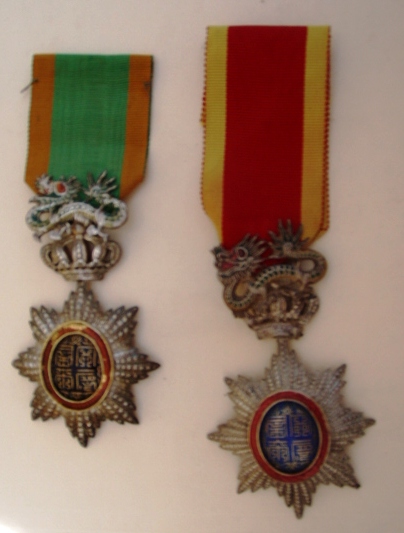 0
0 -
I am too embarrased to show mine after seeing the one you posted. Much of the cloisone on mine (the green dragon scales) have worn off as well as the red oval riband on the pendant. What is interesting is that the green and yellow dragon scales reflect the color of the ribbon which is 7mm yellow, 22mm kight green and 7mm yellow which indicates that it was made in France and awarded by the president. The same medal with a 7mm yellow stripe, 22mm red center stripe and 7mm yellow, would have been awarded by the Emperor. There is another version that has two dark red 7mm edge stripes with a 22mm lighter red center stripe.
Did you say that you purchased the one that you posted?
At a recent H.D. Rauch auction last month the biddibg on one of these started at 2,00 euros. I do not know what the hammer brought.
A good description/history of this medal is contained in the OMSA Monograph "Orders, Decorations, and Medals of the French Overseas and the Post Colonial Periods" by Edward J. Emering.
Dick
Here is a picture of mine. As you can see, it is quite a bit older except for the ribbon. Interestingly it hass a hallmark on the back of the dragon. The letter "A"
Dick

 0
0 -
Very Attractive. I've been meaning to buy one for years.
All I can say is: "Good Luck"
0 -
Thank you for the tip Dick!
I got this medal a few weeks ago from the french ebay site for about 200Euro.
Right now there is a Order of Cambodia Grand Cross with breast star in auction:
http://cgi.ebay.fr/ws/eBayISAPI.dll?ViewIt...em=270409066665
I would love to have the change to go for this one.
a l e x
Alex:
That was an excellent buy and it appears that it is one of the better ones made in Paris.
Thanks for the tip. I'll check it out.
Dick
0 -
Hello Gentleman
I'm looking to expand my collection with a Dragon of Annam medal but french medals are really not my field.
I Like the medals Boxed, so how does the original Box for this medal looks like? Can anyone post a Picture?
I really love the history and specially the design of this medal, one of the most beautifully medals I have ever seen.
So if someone have one, it would be great I see some Pictures and Info's here...

Thank you
a l e x
I am too embarrased to show mine after seeing the one you posted. Much of the cloisone on mine (the green dragon scales) have worn off as well as the red oval riband on the pendant. What is interesting is that the green and yellow dragon scales reflect the color of the ribbon which is 7mm yellow, 22mm kight green and 7mm yellow which indicates that it was made in France and awarded by the president. The same medal with a 7mm yellow stripe, 22mm red center stripe and 7mm yellow, would have been awarded by the Emperor. There is another version that has two dark red 7mm edge stripes with a 22mm lighter red center stripe.
Did you say that you purchased the one that you posted?
At a recent H.D. Rauch auction last month the biddibg on one of these started at 2,00 euros. I do not know what the hammer brought.
A good description/history of this medal is contained in the OMSA Monograph "Orders, Decorations, and Medals of the French Overseas and the Post Colonial Periods" by Edward J. Emering.
Dick
0 -
I disagree. You will often find this on Japanese made non governmental items, however it is more common for items made in the 1950s - 70s than for items made pre war.
This is correct. I should have been more clear and stated that this type pertains to unofficial, non-government, and non-military.
I think your third class may be a second class.
0 -
And the reverse.
The casting of the suspension ring as an integral part of the planchet is not a normal Japanese practice. Nor is the sidewise suspension. This is a common procedure used by modern day 'manufacturers'.
Dick LaTondre
0 -
Undoubtedly many of you saw this item for auction last month. I don't even know if this was authentic or a copy, authentic? Anyway, for those of you that didn't see it, I figured I'd post these pics. as I think this is a gorgeous piece. It sold for ?5,000,000 which if I understood correctly was considerably less than the original price for which the selling owner acquired it. One would not pay this much for a copy, would they??? Anyway, enjoy!

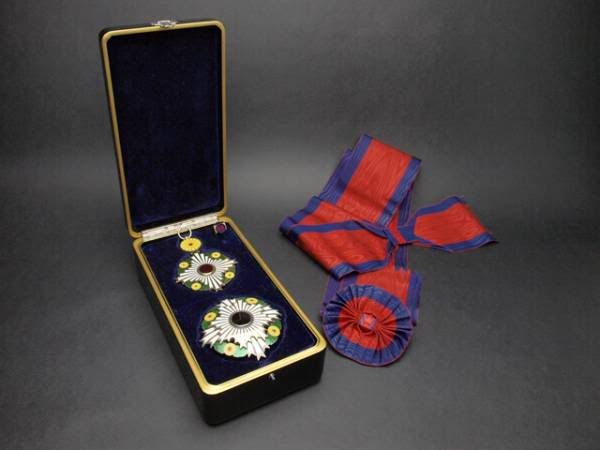
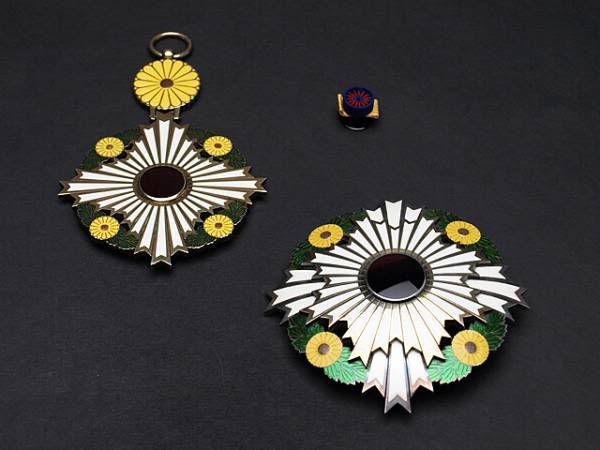
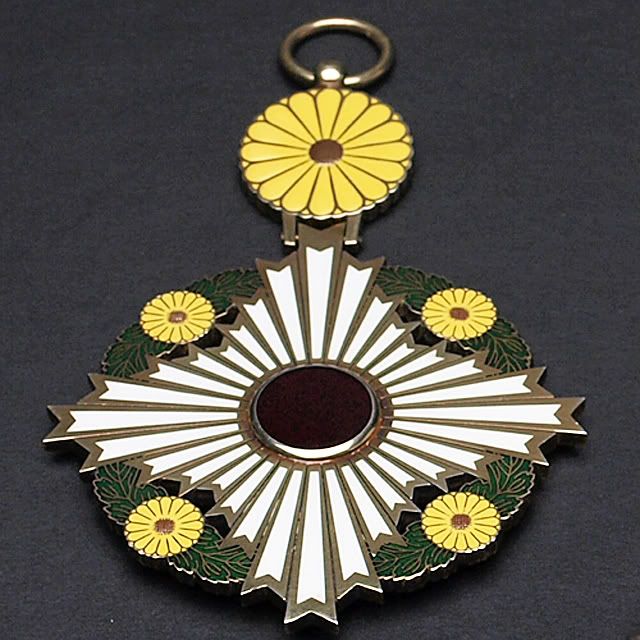
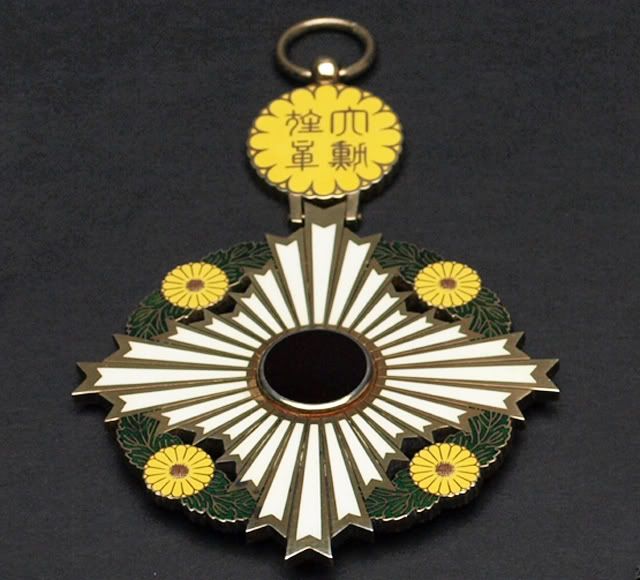
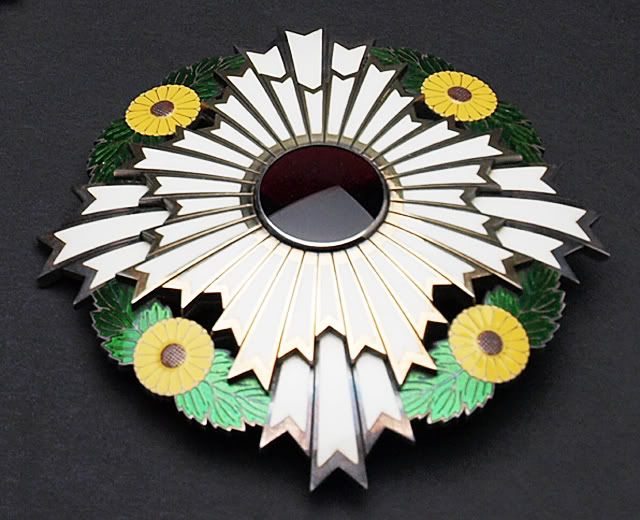
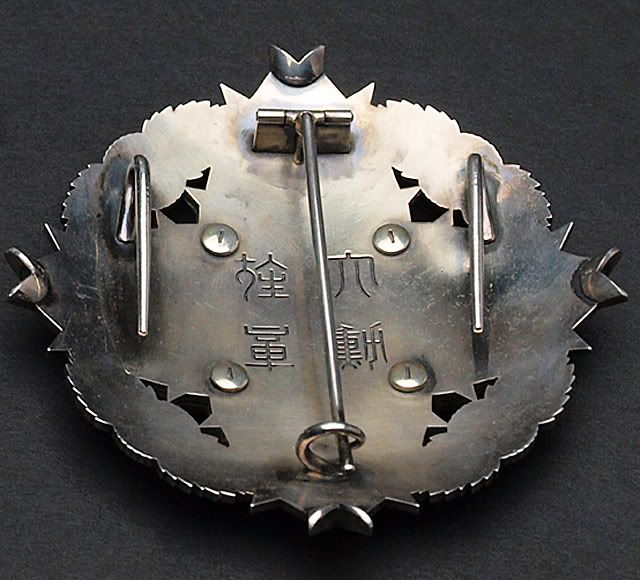
Thanks for the beautiful display. That must be close to US $51,000.00! I wonder what Mike Quigley's Collar is worth?
Dick LaTondre
0 -
Richard,
1)
After researching what I saved in my database, I have found a discussion we made on the OMSA forum (about a similar subject) that I completely have forgotten but that is extremely interesting.You can see it at :
http://www.omsa.org/forums/showthread.php?t=2142What emerged in that occasion was that, if I have well understood what you have written, the 'Order of the Golden Grain (Chia Ho)' and the the 'Order of the Most Precious Brilliant Golden Grain (Pao Kuang)' are two DIFFERENT Orders.
In this instance, if I have well understood, you are describing them as one and the same Order and in particular that the 'Precious Brilliant (Pao Kuang)' is a 'grade' of the 1st class of the Golden Grain (Chia Ho).Can you please better explain the what is correct between the two facts above stated ?
2)Returning to my initial question asked at the starting of this post and regarding the China, Order of the 'Precious and Brilliant Golden Grain', can you strictly confirm that there is a physical evident difference between the badges of the 1st class and the 2nd class of this Order ?3)
Regarding what we discussed in the OMSA forum (
http://www.omsa.org/forums/showthread.php?t=2142), a question still remain un-answered :Have you been able, by now, to ascertain what are the different colours used for the 1st and 2nd class ribbons of the Golden Grain Order (Chia Ho) ??
As previously stated I suspect that the 1st class used a wide yellow central stripe with 2 red edge stripes while the 2nd class had always the wide yellow central stripe but the edges stripes were white in colour.
What can you tell me at this propos ?
Awaiting to hear from you
Best Regards
Lilo
I believe that it may well be the same Order but with later additions. I have no additional information to offer.
King Kwok Cheung wrote an article in the JOMSA in 2002 addressing this possibility. See "Orders of the Golden Grain and Precious Brilliant Golden Grain Republic of China (1912-1929) The Journal of the Orders and Medals Society of America Vol 53, No 3, May-June 2002.
0 -
Lilo:
The Order of the Golden Grain was established 29 July 1912 by President Yuan Shih Kai as an award for outstanding Civil Merit. (Chia Ho).
The order came in two classes:
The First Class Order of the Golden Grain has two grades:
The First Grade which is the Order of the Most Precious Brilliant Golden Grain (Chia Ho Bao Xing). This Grade has five classes with brilliants (I believe the term brilliants refers to the gem stones ((17)) mounted in the circle. i.e., the rubies).
The Second Grade has nine classes without brilliants.
The badge that you have shown from Sothebys is described as an wight pointed gold star upon which has been superimposed a 12 pointed gold rimmed, yellow bordered, red enamel cross. The center medallion portrays on a white enamel background five green and gold sheaves of wheat set in a circular pattern. In the center is a medium sized ruby. The center medallion is surrounded by seventeen small rubies. The badge is suspended from a green and gold laurel wreath.
Richard
0 -
Lilo:
As I am unfamiliar with listing photos on this website, I prefer that you direct your questions regarding medals to the OMSA website at:
http://www.omsa.org/forums/forumdisplay.php?f=50
Do you have any problems with that? The reason is that the OMSA website is designed specifically for medals only. The GMIC website does not specialize in medals. I have information concerning the order with the red stones.
I want to caution you once again about using my photographs without giving the source. The photograph is a reproduction of my copyrighted photo. In order for you to use any of my photos you need to insert the following: "Photo courtesy of Richard LaTondre, Hoover Institution, Stanford University"
Respectfully,
Richard
0 -
I have 1st edition (1967) and 3rd edition (2000) of Peterson, and the illustrations are only in black and white.

If you look more carefully you will find the color photograph illustrated in the color plate section of the Third Edition.
0




Ordre Royale du Cambodge
in South East & East Asia
Posted
Through the courtesy of Hugh here is an image. Thanks Hugh